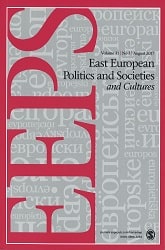Arbiters of Value: The Nationalization of Art and the Politics of Expertise in Early Socialist Romania
Arbiters of Value: The Nationalization of Art and the Politics of Expertise in Early Socialist Romania
Author(s): Emanuela GramaSubject(s): Political history, Government/Political systems, Nationalism Studies, WW II and following years (1940 - 1949), History of Communism, Sociology of Art, History of Art
Published by: SAGE Publications Ltd
Keywords: nationalization; art; socialism; Romania; property;
Summary/Abstract: In 1948, immediately after the Communist Party came to power in Romania, state officials commissioned a group of art experts to radically transform the existing public and private art collections into a national system of museums. These professionals became the new regime’s arbiters of value: the ultimate authority in assessing the cultural and financial value of artwork, and thus deciding their fate and final location. Newly available archival evidence reveals the specific strategies that they employed, and the particular political needs of the state they were able to capitalize on in order to survive and even thrive under a regime that, in principle, should have disavowed them. Even though many of them had professionally come of age during the interwar period, the art experts managed to make themselves indispensable to the new state. They functioned as a pivotal mediator between state officials and a broader public because they knew how to use the national network of museums to put the new state on display. Through the rearrangement of public and private collections across the country, and the centralization of art in museums, they produced a particular “order of things” meant not only to entice the public to view the socialist state as the pinnacle of progress and as a benefactor to the masses but also to validate their expertise and forge a new political trajectory for themselves. The strategic movement of art objects that they orchestrated reveals the material and spatial dimensions of state-making in early socialism.
Journal: East European Politics and Societies
- Issue Year: 33/2019
- Issue No: 03
- Page Range: 656-676
- Page Count: 21
- Language: English
- Content File-PDF

